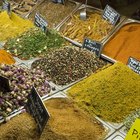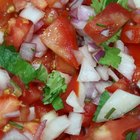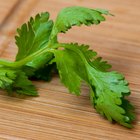Altinosmanaj/iStock/GettyImages
Like many Caribbean cuisines, Trinidadian food draws on a rich mix of cultural influences -- from African and Asian flavors, to Latin American and European techniques. Seasonings include bold spices, fruity rubs, fresh herb dressings and a burst of heat. Trinidadian flavors are probably best represented by the popular "green seasoning," a paste used in so much authentic Trinidadian cooking.
'Tis the Season to be Green
Green seasoning is a classic Trinidad and Tobago blend. It's added to a range of dishes, from meat and fresh seafood, to rich stews and spicy curries. Green seasoning is a vivid green paste with ingredients that vary slightly depending on the chef, and on what's available in the market that day. The green comes from the mix of fresh herbs, such as parsley and thyme and a local herb called chadon beni. Though hard to find in the U.S., chadon beni tastes a little like cilantro. Onion and garlic are always added for extra flavor.
Curry, Trinidad-Style
Curry powder is an essential seasoning in Trinidadian cuisine. In Trinidad, cooks often leave out chili flakes or ground chili, preferring instead to sprinkle fresh chili pepper on food to taste. This means the curry powder is more aromatic than fiery, with cardamon, coriander, cumin, mustard, fenugreek, turmeric, black pepper and a handful of curry leaves all added together before being ground into a powder. Every chef has his own variation on the basic spice blend.
Relish the Taste
Though Trinidadian chutneys and relishes are often used as accompaniments to a main meal, they are also used as a form of seasoning. For example, the popular Trinidadian food roti is often served with sauces such as eggplant relish that enhance the flavor. Kuchela, a relish made from grated green mango, garlic, pepper and chillies, offers another spicy way to enjoy meat roti.
Pick a Pepper
Because a variety of chili peppers grow in Trinidad, from habanero to Scotch bonnet, islanders tend not to use chili powder directly as seasoning. However, expect to find little bowls of finely diced chili pepper on meal tables across the country. A sprinkle of habanero makes any food spicy enough for even the biggest fans of fiery foods.
Related Articles

Afghan Spices

Quesadilla Spices

How Much Turmeric Powder Is in Curry?

Peruvian Cooking Spices

Ancho Chili Powder Vs. Chili Powder

How to Cook with Cilantro

What Is Chili Paste?

What Herbs & Spices Flavor Fish?

How to Make Pico de Gallo

Nutritional Information for Johnny's ...
Good Spices to Put on Tilapia When ...

How to Eat Fennel Seeds

Types of Asian Food

What Is Accent Seasoning?

10 Ingredients That Make Every Recipe ...

Cooking Substitutions for Thai Red ...
What Meat Pairs With Sangria?

Sources of Calcium in Indian Food

What Is Chipotle Seasoning?

What to Bring to a Chili Dinner
References
Writer Bio
Based near London, U.K., Peter Mitchell has been a journalist and copywriter for over eight years. Credits include stories for "The Guardian" and the BBC. Mitchell is an experienced player and coach for basketball and soccer teams, and has written articles on nutrition, health and fitness. He has a First Class Bachelor of Arts (Hons.) from Bristol University.